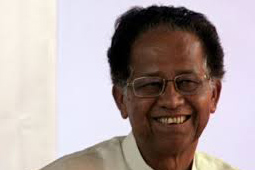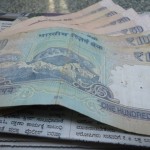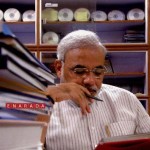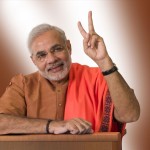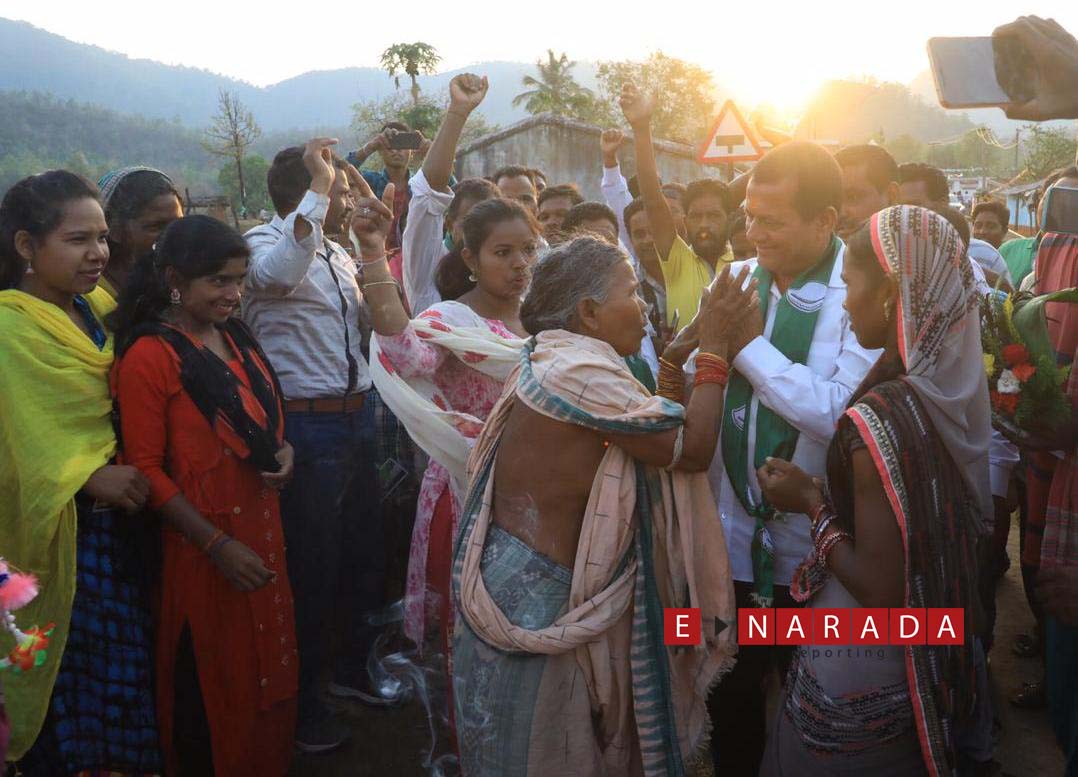ENARADA, New Delhi
By AJAY N JHA
Till recently, the North East used to be low intensity area for national parties. The Congress party had almost taken North- East for granted and used to get the majority of seats from the region. The situation started changing rapidly after regional parties came into the fray and pushed the Congress out in a couple of States.
Leaders of national parties would hardly go beyond Guwahati and barring smaller states like Meghalaya which has a long history of collations breaking way the weeks, the Congress party was able to maintain its dominance in most of the other states.
It was only during the last two years that the BJP started making North East as an important part of its poll strategy and during the last few weeks, North Eastern states have been slightly more fortunate to grab bigger space in national dailies. BJP’s PM candidate Narendra Modi is frequently flying to these states as a part of pre-poll campaign.
The region still remains a Congress bastion as the party is dominant in five out of the eight states — Assam, Arunachal Pradesh, Manipur, Meghalaya, and Mizoram. It is undoubtedly a daunting task for Modi to sway the voters who have hardly sought any alternative for years. That is how he seems to have narrowed down his approach to woo every state individually.
Running election campaigns in 25 Lok Sabha seats spread across eight North- Eastern states may be not be an easy task for the BJP, whose presence in the area is limited to Assam, but the party has been moving strategically to consolidate its base by getting allies and welcoming leaders from other parties to its fold.
“That is why Modi in his speeches has been reminding the people of this region that it was NDA under the leadership of Atal Behari Vajpayee created separate ministries for north-east and tribal affairs, he asserted. Modi has also emphasized that the BJP has the vision and commitment to dispel grievances of people of the region.
He assured after assuming office, NDA government would give special emphasis for overall development of north-east. He has been repeating in almost every speech that his party would come up with viable solutions to the problems of North East and compete on the grounds of performance.
It was his speech at the Arunachal Pradesh rally that should be read cautiously and with lot of introspection. There’s a fear that he might be going overboard with his promises. Modi has certainly projected himself as a stronger and superior alternative to Congress leadership when it comes to Gujarat, but his recent comments on national issues could be tad unsettling. Apart from praising the state’s tourism potential with a focus on ‘Buddhist tourism’, he assured the natives that “no power in the world can snatch away the state from India”.
The BJP is smelling of win in Aruncahal Pradesh this time. It has brought in Kiren Rijiju who was elected to the Lok Sabha for the first time in 1994 from Arunachal Pradesh, the largest state in the Northeast which spreads over 83.743 square km and having a population of 10.96,702, had been active in social activities long before he joined the BJP. Kiren had lost the last Parliamentary by only 1.5 thousand votes and he is pitted this time against Sanjay Takam of Congress party for Arunachal East seat.
In Arunachal West, Tapir Gao has been fielded by the BJP against the sitting Minister in UPA II government. But this area comes under the impact of NSCN and Trap and Chamling districts would hold the key where the BJP candidate has a distinct advantage.
However, a lot would depend upon whom the voters would vote in the Assembly polls which is also happening simultaneously.
Manipur is another State where the BJP can think of at least winning one seat. The selection of candidate would matter a lot in both Manipur inner and outer seats. The Congress party is fielding its old candidate. However, the catch here is the MSCP which has been by and large maintained and funded by Chief Minister Okaram Ibobi Singh. Moreover, NSCN still plays a very important role in that area and there are indications that the BJP would finally decide to field a NSCN- supported candidate.
Nagaland could be slightly different ball game because Chief Minister Neiphiu Rio is from NPF which may support NDA.
Meghalaya would see an interesting battle in Tura of Garo Hills where former Speakar Purno A Sangma would be testing waters against Chief Minister Mukul S Sangma’s candidate. It is going to be a tough fight because Mukul Sangma has emerged as the undisputed leader of the Garos and he would like to maintain that streak.
In Shillong however, a BJP supported UDP candidate may have an advantage and the Congress candidate would find the going tougher.
As far as Sikkim is concerned, the ruling STF party headed by Chief Minister Pawan Chamling would have the advantage.
In Tripura, the BJP would stand no chance because it is a strong communist bastion and the fight has been between CPM and Congress there.
Assam is the most important State in the North East with 14 parliamentary seats. In 1999, the BJP had won only 2 seats but remained on second position in almost all other seats. As of now, all the four sitting MPs are likely to return to Parliament and the advantage would be the Lakhimpur seat where the BJP is going to field APCC President Sarbananda Sonwal against Congress party’s Rani Nara. In addition, BJP may as well support a Bodo party candidate in Kokrajhaar.
Overall, there is going to be a triangular fight on most of the seats between the Congress AIUDF and BJP and it was at this backdrop that Modi, in his Guwahati rally, played his Hindu card rather vociferously in his attempt to create polarization based on religion. While in Assam, he tried to touch upon some sensitive issues such as infiltration. Giving a clear religious tone to his ideas, he suggested that all states must accept ‘Hindu refugees’ from Bangladesh and the burden should not be only on Assam. He harped on the apprehension of indigenous people that Bangladeshi Muslims would become the majority. That is perhaps not the wise way of winning voters’ confidence.
Modi not only lampooned the Prime Minister for not reaching out to Assam as frequently as he does. He also held chief minister responsible for not doing enough for the state when it was jeopardized by floods in 2012. According to him, Assam government has been abusing people in detention camps. He also made a promise to close down detention camps in Assam and fight against human rights violations. Proclaiming it as a Congress’ design to prevent its detractors from voting, he urged the poll panel to allow 1.43 lakh ‘doubtful’ or ‘disputed’ voters to cast their votes.
The BJP, which still has not been able to forge an alliance with the Asom Gana Parishad (AGP) for the 2014 elections, got a shot in the arm as two senior leaders of the latter crossed over to join them. Even former speaker P A Sangma-led National People’s Party (NPP) announced that they would contest on nine seats in alliance with the BJP-led NDA.Former AGP president Chandra Mohan Patowary and former AGP minister Hitendra Nath Goswami joined the BJP.
In 2009, the BJP had won four seats out of the 14 seats in alliance with the AGP which had won one seat. As both partners parted ways, they lost in the Assembly elections, which saw Tarun Gogoi becoming the state Chief Minister for the fourth time.
The BJP has been working on raising issues like illegal migration from Bangladesh, torture of Hindus in neighbouring countries and protecting the territorial integrity of the country to find resonance with the local voters. Local leaders concede that it was Gogoi who took the aggressive hindutva line during the last Assembly elections, and that, he managed to score over the saffron party. However, the BJP too has been working hard to woo the core Hindutva constituencies in the state.
The BJP has also stitched an alliance with the NPP. Sangma whose candidature for the Presidential polls in 2012 were actively supported by the NDA, is a natural ally for the saffron party. Sangma would now contest from Tura Lok Sabha consitutency in Meghalaya, a seat currently held by his daughter Agatha Sangma.
The BJP has been gradually expanding its sphere of influence in Assam by attracting Asom Gana Parishad (AGP) leaders and workers. Several AGP leaders have joined the BJP in the last one year, the latest being Atul Bora, who was one of the founding members of the AGP and a prominent face of the Assam agitation. Bora, who was a minister in the erstwhile Prafulla Mahanta government, joined the BJP last month. Another leader, Sarbanand Sonowal, a prominent youth face of the AGP, joined the BJP last year and is now the president of the state unit.
In the Guwahati Municipal Corporation election in June, the BJP got 11 out of 31 seats to come second after the Congress (19), which is running the state government. The AGP, which was a major force in Assam till recently, got just one seat. Interestingly, in two municipal wards, the BJP lost by just four and nine votes, whereas in two others, the difference was just less than 100 votes.
The BJP is planning to raise the Bangladeshi infiltration issue in a big way ahead of the next Lok Sabha elections. “There has been an extraordinary growth in the number of Muslim population in the last few years. In 1971, Muslims were 24.5% of the total state population. This went up to 33% as per the 2011 Census. What explains this demographic profile? This is not a case of family size growth. Instead it’s a result of infiltration from Bangladesh,” said a senior local BJP leader.
On the other hand, the congress party is in the throes of redefining its approach towards the All India United Democratic Front (AIUDF) in the State.
The AIUDF, represented by Maulana Badruddin Ajmal, MP from Dhubri Lok Sabha constituency, is a constituent of the UPA Government at the Centre. But in Assam, Ajmal is pariah to a Congress Chief Minister Tarun Gogoi. The Chief Minister had consistently accused Ajmal of harbouring a communal agenda. He rejected AIUDF’s overtures for political alliance with the Congress. This endeared Gogoi to the Hindus of Assam, whether Assamese or Bengalis, concerned at the lengthening shadow of the crescent on the North-eastern State.
In the 2011 Assembly elections, the Hindus felt Gogoi was their best bet, since neither the BJP nor the AGP had taken any definite position on Ajmal. Both these parties wanted to get rid of the Congress at any cost. The Hindus realised that the ‘cost’ might mean greater Islamisation of Assam, if a coalition Government with Ajmal’s support were to replace the Congress. Therefore, they decided to give Gogoi a thumping majority so as to preclude Ajmal’s party from the corridors of power. The electorate was polarised on communal lines. The Hindu vote consolidated in favour of Gogoi, while Muslims rallied behind Ajmal. The AIUDF won 18 out of 78 seats it contested, 16 of them Muslims. But Congress not merely bucked the two-time anti-incumbency but increased seat count from 53 to 78. The Hindu nationalist BJP was routed. It won just five out of 120 seats it contested, forfeiting deposit in as many as 84.
The rise of Modi Mania has changed the atmosphere and started giving sleepless nights to Congress leaders. Congress hopes for increasing its mandate in 2014 by building on 2011 Assembly poll results. But it has been taken aback by Modi’s sweeping popularity. It is groping for the right formula to have a pre-poll alliance with AIUDF. Central leadership is keen to patch up with AIUDF for its enhanced stature amongst the Muslims. But it is unwilling to give up on the ‘Hindu vote’ now threatened by the rise of Modi. One need to flip through the pages of Bengali, Assamese and Hindi dailies to find articles and letters to the editor in support of Modi.
Keeping Silchar and Karimganj in mind Gogoi recently pitched for refugee status for Hindus who had entered Assam from Bangladesh even after March 25, 1971. Previously, all parties (except the BJP) treated all illegal immigrants after March 25, 1971 as infiltrators regardless of religion. This was Gogoi’s attempt to outsmart BJP. The BJP favoured putting Hindu refugees on a different footing from Muslim immigrants. But ‘Hindu Bengali Protection Committee’ affiliated to the BJP described it as Gogoi’s bluff. Gogoi had said the same thing prior to 2011 Assembly election but did precious little in the last two years.
Many political pundits in Guwahati admit that Gogoi’s third term with enhanced mandate is actually proving to be disastrous. The Government is apparently on auto pilot. Two of his Ministers Himanta Biswa Sarma and Rakibul Hassan are engaged in mudslinging over galloping instances of poaching in Kaziranga National Park. With neither New Delhi nor Guwahati having any sense of direction, little surprise, the people of Assam are looking towards Modi.
Less than a month ago, BJP’s prime ministerial candidate Narendra Modi had said he continued to be an untouchable for many in the country while party leaders maintained that the numbers after Lok Sabha elections will dictate the political equations. Encouraged by the trickle of allies moving into the NDA fold, the BJP is exploring all possible pre-poll tie-ups and electoral understanding in states where it is politically weak. After finalising its alliance in crucial states like Bihar and Maharashtra, the BJP is reaching out to smaller parties in Odisha, Tamil Nadu and Assam as well.
A BJP leader said that two months ago the question being asked was whether the saffron party will get allies but now the party’s alleged pariah status appears to be waning.
Modi has been silent on issues like temple and uniform civil code and emphasizing on his vision for economic development. In his recent rallies in Bihar and UP, Modi’s speeches have revolved around giving priority to socially and economically backward sections of society.
Even if some of the allies are just fringe parties, they are crucial in the party’s strategy to improve its vote share across states and send out a political message. That is precisely team Modi has been working on.
(Posted on March 14, 2014 @ 6pm)
(Ajay N Jha is a veteran journalist from both Print and Electronic media. He is Advisor to Prasar Bharti. The views expressed are his personal. His email id is Ajay N Jha <ajayjha30@gmail.com> )
The views expressed on the website are those of the Columnists/ Authors/Journalists / Correspondents and do not necessarily reflect the views of ENARADA.

